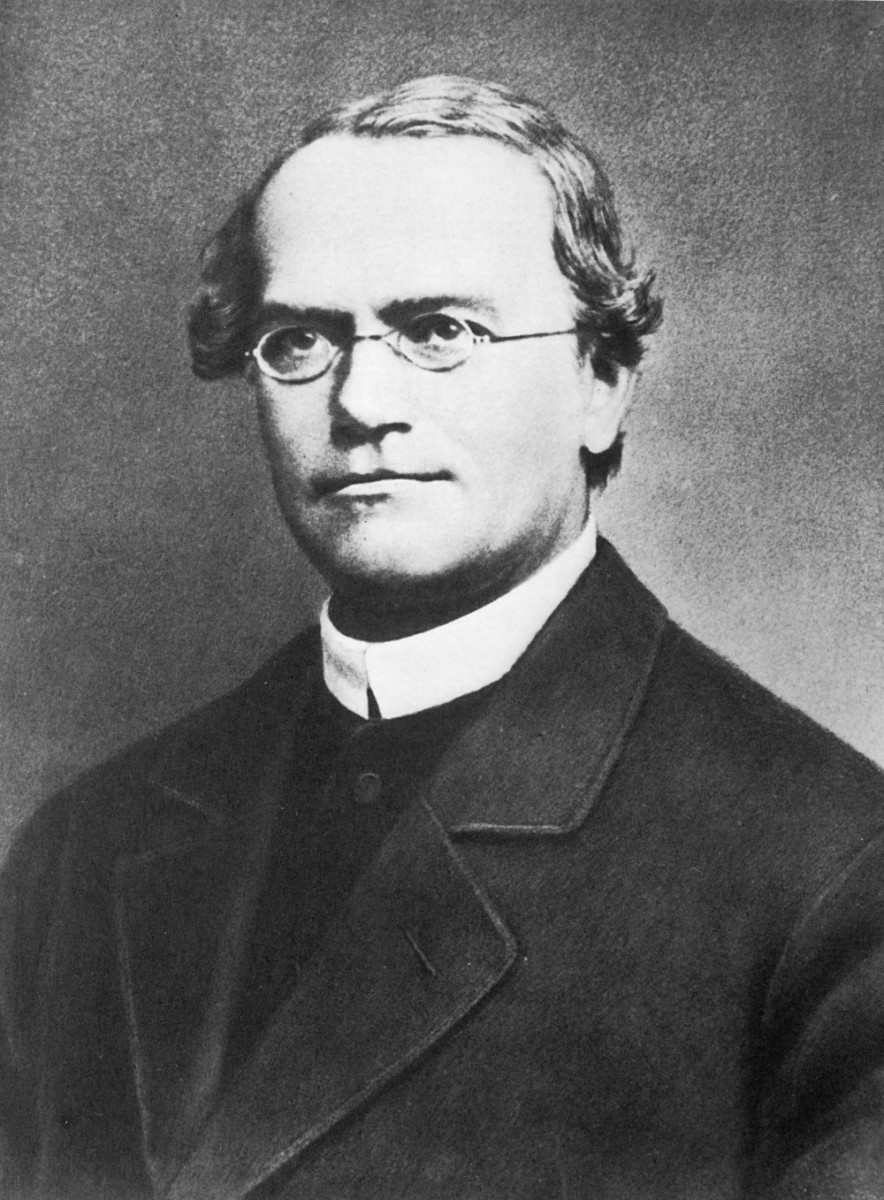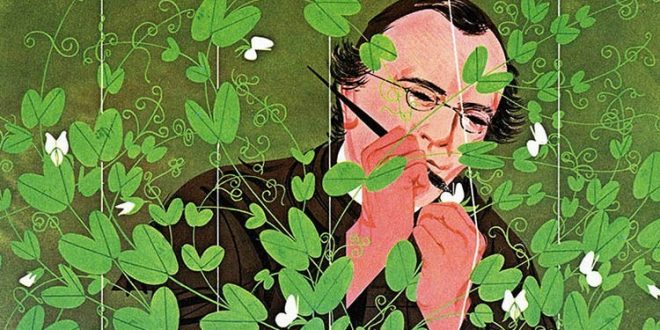In this article we will discuss (c) Life of Gregor Johann Mendel, his experiments and achievements; reasons of Mendels success.
Gregor Johann Mendel who is the father of genetics, was born in 1822. In this article we will know him and his works elaborately.
Life of Gregor Johann Mendel, His Experiments and Achievements;
Reasons of Mendels Success
As you can see we have three sub-division in this topic. So we will discuss it one by one.
Gregor Johann Mendel
We are talking about Mendel too much, aren’t we? You may think who is this person? Why is he so important? Of course he is important. After all he is the father of genetics.
We all know him from our childhood. But here we will discuss about his identity and works elaborately.
Father of Modern Genetics
The first person to trace the characteristics of successive generations of a living thing
 |
|
Where Mendel Studied
- Gregor Mendel then attended the Augustinian Monastery and became a monk.
He was later sent to the University of Vienna to study science and math. By both his professors at University and his colleagues at the monastery, Mendel was inspired to study variance in plants.


How Mendel Got Started
- Mendel’s attraction to research was based on his love of nature.
- He was not only interested in plants, but also in meteorology and theories of evolution.
- Mendel often wondered how plants obtained atypical characteristics

The Birth of The Idea: Heredity
- On a walk around the monastery, he found an atypical variety of an ornamental plant.
- He took it and planted it next to the typical variety.
- He grew their progeny side by side to see if there would be any approximation of the traits passed on to the next generation.
- This experiment was “designed to support or to illustrate Lamarck’s views concerning the influence of environment upon plants.”
- He found that the plants’ respective offspring retained the essential traits of the parents, and therefore were not influenced by the environment.
Mendel’s Research Reflected His Personality
| Once he crossed peas and mice of different varieties “for the fun of the thing,” and the phenomena of dominance and segregation “forced themselves upon notice.”
He saw that the traits were inherited in certain numerical ratios. |
He then came up with the idea of dominance and segregation of genes and set out to test it in peas.
It took seven years to cross and score the plants to the thousand to prove the laws of inheritance! |
Mendel’s Laws of Heredity
From his studies, Mendel derived certain basic laws of heredity:
- Hereditary factors do not combine, but are passed intact;
- Each member of the parental generation transmits only half of its hereditary factors to each offspring (with certain factors “dominant” over others);
- Different offspring of the same parents receive different sets of hereditary factors.
Mendel’s work became the foundation for modern genetics
- The impact of genetic theory is no longer questioned in anyone’s mind.
- Many diseases are known to be inherited
- And pedigrees are typically traced to determine the probability of passing along a hereditary disease.
- Plants are now designed in laboratories to exhibit desired characteristics.
- The practical results of Mendel’s research has not only changed the way we perceive the world, but also the way we live in it.
Some interesting Facts
Best safe and secure cloud storage with password protection
Get Envato Elements, Prime Video, Hotstar and Netflix For Free
Best Money Earning Website 100$ Day
#1 Top ranking article submission website
- Took seven years to prove laws of inheritance
- Mendel’s works became the foundation of modern genetics
- Later crossed mice and pea plants
- Noticed traits were inherited in certain numerical ratios
- Came up with idea of dominance and segregation of genes and set out to test it in peas
- Love of nature encouraged his interest in research
- Also interested in meteorology and theories of evolution
Genotype and Phenotype
Heredity traits are under the control of genes (Mendel called them factors)
Genotype is the genetic makeup of an organism, a description of the the genes it contains.
Phenotype is the characteristics that can be observed in an organism.
Phenotype is determined by the interaction of genes and environment.
* Genes provide the potential, but environment determines whether the potential is realized ???
Influences on the physical manifestation (phenotype) of the genetic blueprint (genotype):

Alternative Forms of Traits are Alleles
Each trait carries two copies of a unit of inheritance, one inherited from the mother and the other from the father.

Mendel and his experiments
An Austrian monk, Gregor Mendel, developed the fundamental principles that would become the modern science of genetics.
Mendel demonstrated that heritable properties are parceled out in discrete units, independently inherited. These eventually were termed genes.

Mendel reasoned an organism for genetic experiments should have:
- a number of different traits that can be studied
- plant should be self-fertilizing and have a flower structure that limits accidental contact
- offspring of self-fertilized plants should be fully fertile.
Mendel’s experimental organism
- It was a common garden pea (Pisum sativum), which has a flower that lends itself to self-pollination.
- The male parts of the flower are termed the anthers. They produce pollen, which contains the male gametes (sperm).
- The female parts of the flower are the stigma, style, and ovary. The egg (female gamete) is produced in the ovary.
- The process of pollination (the transfer of pollen from anther to stigma) occurs prior to the opening of the pea flower.
- The pollen grain grows a pollen tube which allows the sperm to travel through the stigma and style, eventually reaching the ovary.
- The ripened ovary wall becomes the fruit (in this case the pea pod).
Why Pea ????
Mendel tested all 34 varieties of peas available to him through seed dealers. The garden peas were planted and studied for eight years. Mendel’s experiments used some 28,000 pea plants.
- Since pea plants are self-pollinators, the genetics of the parent can be more easily understood.
- Peas are also self-compatible, allowing self-fertilized embryos to develop as readily as out-fertilized embryos.
- Pea has as many as seven contrasting characteristics. Each character studied had two distinct forms, such as tall or short plant height, or smooth or wrinkled seeds.
- Pea is annual herb. So the result of the hybridization (crossing) will have in short time.
- Comparatively flower size is suitable for artificial hybridization.
- All the seeds produced as a result of hybridization are viable.
Mendel’s experiment
7 contrasting characteristics



Mendel’s contribution was unique because of his methodical approach to a definite problem, use of clear-cut variables and application of mathematics (statistics) to the problem. Gregor Using pea plants and statistical methods, Mendel was able to demonstrate that traits were passed from each parent to their offspring through the inheritance of genes.
Mendel’s work showed:
- Each parent contributes one factor of each trait shown in offspring.
- The two members of each pair of factors segregate from each other during gamete formation.
- The blending theory of inheritance was discounted.
- Males and females contribute equally to the traits in their offspring.
- Acquired traits are not inherited.
Principle of Segregation
- Mendel studied the inheritance of seed shape first.
- A cross involving only one trait is referred to as a monohybrid cross.
- Mendel crossed pure-breeding (also referred to as true-breeding) smooth-seeded plants with a variety that had always produced wrinkled seeds (60 fertilizations on 15 plants).
- All resulting seeds were smooth. The following year, Mendel planted these seeds and allowed them to self-fertilize.
- He recovered 7324 seeds: 5474 smooth and 1850 wrinkled. To help with record keeping, generations were labeled and numbered.
- The parental generation is denoted as the P1 generation. The offspring of the P1 generation are the F1 generation (first filial).
- The self-fertilizing F1 generation produced the F2 generation (second filial).

 |
P1: smooth X wrinkled F1 : all smooth F2 : 5474 smooth and 1850 wrinkled
|

|
NOTE: Mendel studied seven traits which appeared in two discrete forms, rather than continuous characters which are often difficult to distinguish. When “true-breeding” tall plants were crossed with “true-breeding” short plants, all of the offspring were tall plants. The parents in the cross were the P1 generation, and the offspring represented the F1 generation. The trait referred to as tall was considered dominant, while short was recessive. Dominant traits were defined by Mendel as those which appeared in the F1 generation in crosses between true-breeding strains. Recessives were those which “skipped” a generation, being expressed only when the dominant trait is absent. Mendel’s plants exhibited complete dominance, in which the phenotypic expression of alleles was either dominant or recessive, not “in between”. When members of the F1 generation were crossed, Mendel recovered mostly tall offspring, with some short ones also occurring. Upon statistically analyzing the F2 generation, Mendel determined the ratio of tall to short plants was approximately 3:1. Short plants have skipped the F1 generation, and show up in the F2 and succeeding generations. Mendel concluded that the traits under study were governed by discrete (separable) factors. The factors were inherited in pairs, with each generation having a pair of trait factors. We now refer to these trait factors as alleles. Having traits inherited in pairs allows for the observed phenomena of traits “skipping” generations. |
Summary of Mendel’s Results
- The F1 offspring showed only one of the two parental traits, and always the same trait.
- Results were always the same regardless of which parent donated the pollen (was male).
- The trait not shown in the F1 reappeared in the F2 in about 25% of the offspring.
- Traits remained unchanged when passed to offspring: they did not blend in any offspring but behaved as separate units.
- Reciprocal crosses showed each parent made an equal contribution to the offspring.
Mendel’s Conclusions
- Evidence indicated factors could be hidden or unexpressed, these are the recessive traits.
- The term phenotype refers to the outward appearance of a trait, while the term genotype is used for the genetic makeup of an organism.
- Male and female contributed equally to the offsprings’ genetic makeup: therefore the number of traits was probably two (the simplest solution).
- Upper case letters are traditionally used to denote dominant traits, lower case letters for recessives.
Mendel reasoned that factors must segregate from each other during gamete formation (remember, meiosis was not yet known!) to retain the number of traits at 2. The Principle of Segregation proposes the separation of paired factors during gamete formation, with each gamete receiving one or the other factor, usually not both. Organisms carry two alleles for every trait. These traits separate during the formation of gametes.
We have finished part II. See you in part III
 Plantlet The Blogging Platform of Department of Botany, University of Dhaka
Plantlet The Blogging Platform of Department of Botany, University of Dhaka





Your article helped me a lot, is there any more related content? Thanks!